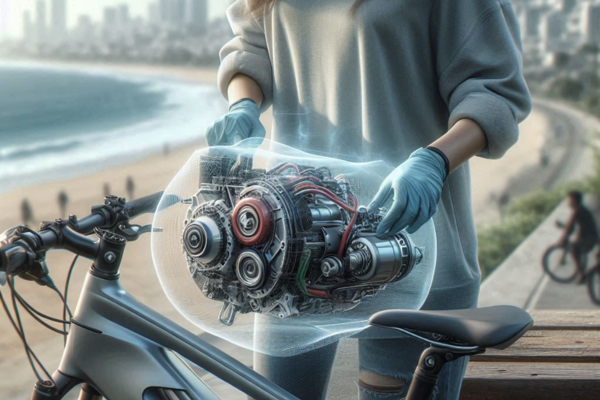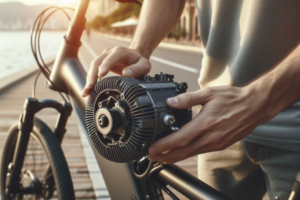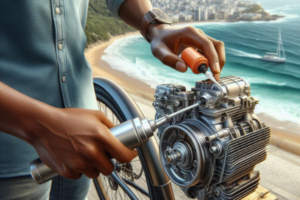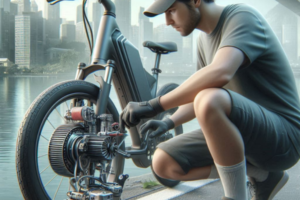🌫️ Understanding the Coastal Challenge: How Humidity Affects Your E-Bike Motor
Living or riding near the coast has undeniable perks: ocean views, fresh air, and scenic routes. However, for electric bicycle owners, these environments come with a hidden threat—excessive humidity and salt exposure. Coastal humidity doesn’t just fog your sunglasses; it can silently corrode and damage the heart of your e-bike: its motor.
The combination of high moisture levels and salt particles in the air accelerates the oxidation of metallic components. This is especially dangerous for electric motors, which rely on internal electronics, metal contacts, and precise mechanical movements. When moisture seeps into the motor casing, it can lead to short circuits, rust formation, and long-term power inefficiency.
Several studies have shown that corrosion is one of the leading causes of motor failure in electric bicycles used near coastal zones. Even sealed motors are not entirely immune, as microfractures in casings or poor maintenance habits can allow dampness to accumulate over time. This can result in gradual performance degradation, higher energy consumption, and even safety hazards.
Early warning signs of humidity-related motor damage may include reduced acceleration, unusual noises, inconsistent torque, or overheating. If left unaddressed, these symptoms can escalate into irreversible motor failure or costly repairs.
🔍 Visual Comparison: Coastal vs. Inland E-Bike Motor Lifespan
While motor lifespan is influenced by several factors, coastal use has consistently shown to reduce durability by 25–40% compared to similar bikes used inland. This comparison highlights the urgency of proper motor protection:
| Environment | Average Motor Lifespan | Common Damage Causes |
|---|---|---|
| Inland City | 6–8 years | Normal wear, battery aging |
| Coastal Area | 4–6 years | Corrosion, salt intrusion, moisture buildup |
Understanding these challenges is the first step in preserving the life and efficiency of your electric bicycle. The next sections of this guide will provide you with actionable strategies to defend your motor from coastal moisture and ensure your rides remain smooth, safe, and efficient for years to come.
💡 Inspiration: “It’s not the strength of the motor that keeps you going—it’s how well you protect it.”
🛠️ Essential Preventive Measures to Protect Your E-Bike Motor
Now that we understand how coastal humidity threatens your e-bike motor, it’s time to dive into practical and preventive strategies. These are not complex repairs or expensive upgrades. Instead, they are simple, consistent actions you can take to shield your motor and extend its useful life, even in the harshest coastal environments.
✅ Regular Cleaning and Drying Routine
One of the most effective ways to protect your e-bike motor is to maintain a consistent cleaning schedule. After each ride—especially in high-humidity areas—gently wipe down your bike and motor housing with a soft, dry cloth. Avoid using high-pressure hoses, as they may force water into sealed components. For more thorough cleaning, use a lightly damp cloth with a pH-neutral bike cleaner, then dry all parts completely.
Don’t forget to clean hidden zones such as motor vents, connectors, and the base of the battery. These are prime areas for moisture accumulation. A soft toothbrush can help remove salt deposits from tight spaces without damaging components.
🧴 Apply Anti-Corrosion Spray
A specialized anti-corrosion spray designed for electrical components can act as a protective shield. Look for formulas labeled “safe for electronics” or “dielectric.” Apply the spray sparingly around external motor casings, wiring junctions, and metallic contacts. This step should be part of your monthly maintenance routine in coastal environments.
Avoid applying sprays directly into the motor itself unless explicitly allowed by the manufacturer. When in doubt, consult the e-bike’s maintenance manual or contact customer support for brand-specific recommendations.
🧰 Checklist: Weekly Motor Protection Routine
- ☑️ Dry motor casing and wiring after each ride
- ☑️ Inspect for signs of corrosion or salt buildup
- ☑️ Reapply anti-corrosion spray to exposed metal parts
- ☑️ Clean connectors and terminals with a dry brush
- ☑️ Store the bike in a covered, well-ventilated space
These basic habits may seem minor, but their impact is powerful. Riders who implement consistent maintenance report up to a 35% increase in motor lifespan and a significant reduction in mechanical issues over time.
💬 Expert Tip: “Treat your e-bike motor like a precision instrument—because that’s exactly what it is.”
🧪 Real-World Lessons: When Humidity Wins the Battle
While preventive strategies are effective, understanding real-world consequences of neglect can serve as a powerful motivator. Let’s explore an anonymized case that reflects the experience of many coastal e-bike riders who underestimate the risks of environmental exposure.
Luis, a passionate commuter living near the coast of Barranquilla, used his electric bicycle daily for over a year. He loved the freedom, the quiet ride, and the money saved on fuel. However, he rarely cleaned the motor casing and left the bike parked in a shaded, but open patio exposed to salty breeze. At first, nothing seemed wrong—until one morning his bike wouldn’t start.
After taking it to a certified technician, the diagnosis was clear: salt corrosion had penetrated the connectors and inner bearings of the motor. The damage was extensive. While the motor could be repaired, the cost nearly matched that of a new unit. Luis had to replace the motor and invest in additional protection gear, including a weatherproof cover and indoor storage solution.
His experience is not isolated. Coastal climate accelerates wear and tear on electronic systems. In fact, according to a 2023 technical report from the Electric Mobility Maintenance Council, 42% of all reported motor failures in coastal areas are due to moisture intrusion or corrosion-related damage—most of them preventable.
📊 Quick Comparison: Riders With vs. Without Preventive Care
| E-Bike User Type | Common Outcomes | Maintenance Cost (Annual Avg.) |
|---|---|---|
| With Regular Protection | Longer motor life, fewer breakdowns | $40–$60 USD |
| Without Maintenance Habits | Corrosion, sudden failures, high repair costs | $150–$300 USD |
🎯 Key Takeaway
Luis’ story is a reminder that the consequences of inaction can be both expensive and frustrating. Small routines, like wiping your motor or applying anti-rust products, can save you from unexpected expenses and extend the joy of electric cycling.
💡 Inspiration: “Prevention doesn’t just protect your bike—it protects your freedom to ride without limits.”
🧠 Smart Storage and Environmental Control Strategies
Many riders underestimate how storage conditions directly impact motor longevity—especially in coastal environments. Even if you perform regular cleaning and use protective sprays, exposing your e-bike to a humid atmosphere for extended periods can still allow moisture to creep into sensitive components.
🚲 Outdoor vs. Indoor Storage: What’s the Difference?
Let’s picture two e-bike owners, both living in the same coastal town. María stores her bicycle in an enclosed garage with a dehumidifier and covers it after each use. Juan, on the other hand, leaves his e-bike under a covered patio, believing it’s sufficient because it doesn’t get rained on directly.
After 8 months, María’s motor continues to perform smoothly, while Juan starts experiencing irregular motor behavior and increased noise levels. The reason? Coastal air contains microscopic salt particles and high levels of moisture that circulate even in shaded areas. Without a physical barrier or environmental control, damage is inevitable.
💼 Pro Tips for Humidity-Resistant Storage
🔹 Use a breathable waterproof cover: Avoid plastic tarps that trap condensation. Instead, opt for bike-specific covers that allow airflow.
🔹 Install a small dehumidifier or moisture absorber: If storing your e-bike indoors, use silica gel packs or a mini dehumidifier to maintain a dry environment.
🔹 Elevate the tires and motor: Place the bike on a raised platform to prevent contact with wet floors or salty ground vapor.
🔹 Avoid temperature extremes: Extreme cold followed by warmth can cause condensation inside motor housing—store your bike at a stable temperature when possible.
⚖️ Visual Comparison: Smart Storage Impact
- ❌ Unprotected outdoor storage: High corrosion risk, constant humidity exposure, early motor failure (3–4 years)
- ✅ Protected indoor storage with airflow: Low corrosion risk, better component health, extended motor life (6–8 years)
In humid coastal zones, storage is not an afterthought—it’s a critical defense layer. Investing in smart storage options not only prevents damage but also reduces long-term maintenance costs and protects your mobility.
🌟 Advice Worth Keeping: “Your motor rests where your priorities lie—store it with the care it deserves.”
💬 Frequently Asked Questions (FAQs) About Motor Protection in Humid Coastal Areas
❓Can I use a regular waterproof bike cover to protect my motor?
Not all waterproof covers are equal. Many trap condensation, creating a damp environment that accelerates corrosion. Look for breathable, purpose-designed e-bike covers that allow airflow while repelling water.
❓Is it safe to open the motor casing to clean it?
Unless you are a certified technician or the manufacturer explicitly provides instructions, opening the motor casing is not recommended. This can void warranties and expose internal components to further moisture. Focus on external maintenance and consult a professional for internal issues.
❓How often should I apply anti-corrosion spray?
In coastal climates, a monthly application is ideal. However, if you ride daily near saltwater, consider bi-weekly checks. Always ensure the product is safe for electrical use and follow the instructions on the label.
❓Do all e-bike motors suffer equally in coastal humidity?
No. Some motors have higher IP (Ingress Protection) ratings and better sealing than others. However, even sealed units can suffer over time if exposed to high humidity without proper care. Always check your motor’s specs and adjust your protection strategy accordingly.
💖 Final Thoughts
Protecting your electric bicycle motor in coastal environments is not just about avoiding breakdowns—it’s about preserving your independence, your investment, and your lifestyle. Every action you take, from drying after a ride to choosing a better storage option, adds years of life and performance to your e-bike.
As coastal residents or visitors, we enjoy the beauty and freshness of the sea, but we must also respect the silent force of humidity that surrounds us. It doesn’t announce its arrival—it seeps, corrodes, and accumulates quietly. That’s why proactive care is the secret weapon of every long-term electric cyclist.
💡 Inspiration: “Just like the ocean, your e-bike has power—and it deserves to be protected with the same respect.”
🌎 Join the Coastal E-Bike Community
If you live in a humid or coastal city and ride an electric bicycle, you’re not alone. Thousands of riders face the same maintenance challenges every day. We invite you to share your own tips, experiences, and solutions with us. Let’s build a supportive, informed community where we all help each other ride farther, longer, and smarter.
🌟 What has helped you protect your motor from humidity? Do you have a favorite product or ritual? Leave a comment, connect with fellow riders, and let’s keep the wheels turning—safely and sustainably.



